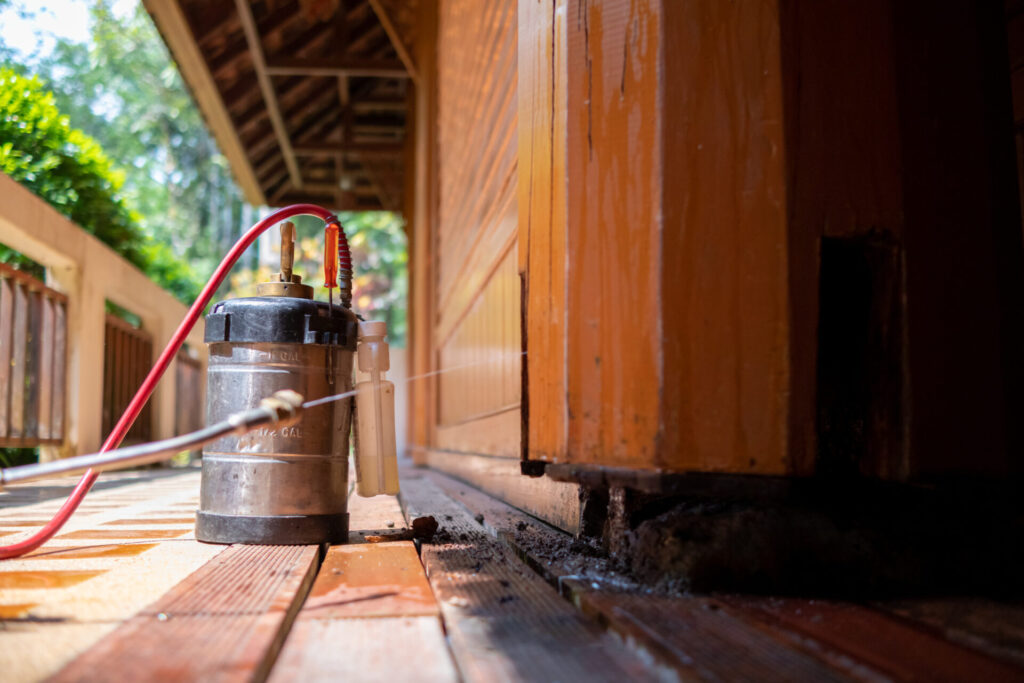Ask any homeowner – what’s your nightmare scenario? Almost to a one, their response will be quick and emphatic: termites. For more than 140 million years, these insects have swarmed across the face of the planet, devouring wood and other plant fibers. Since the first humans began building with wood, termites have been there to turn those buildings into dust.
Unfortunately, the destructive little pests – three species of them, anyway – find our Macon, Georgia region, with its hot, humid summers and ample pines and hardwoods to be an absolutely perfect place to settle down. Scientists estimate that every acre of ground in Georgia is home to somewhere between 800,000 and 10 million termites, each one champing at the bit to get their tiny jaws around your home’s wooden structure, trim, and furnishings.
Fortunately, there’s no reason to panic. In our age-old fight against the tiny but costly termite, we’ve developed several tools to run off invading pests and keep them away for good. Whether you live in one of Macon’s beautiful antebellums or a custom-built new house, here are some ways your Macon, Georgia, pest control team keeps termites in check and your home intact.
Spotting a Macon, Georgia Termite Infestation
While our article from earlier this year, “How to Spot Termites in Your Home,” goes into more detail, there are some main warning signs to be on the lookout for. Seeing any of these by themselves should be enough to get you on the phone with a reputable and licensed pest control company, and seeing several of these indicators may mean that you’re in the midst of a full-blown infestation:
- Buckling or blistering wood floors
- Wood that’s been hollowed out or covered in tunnels and holes
- Mud tunnels on your foundation or exterior walls
- Swollen or bulging drywall
- Wood dust or “frass” (termite droppings)
- Piles of discarded termite wings
Driving off a Macon, Georgia Pest Problem
If you’ve noticed any of the warning signs or symptoms of an active termite infestation, you’re probably experiencing a pretty wide range of emotions, from anger or despair to an uncharacteristic desire to burn it all down and move into a wood-free structure somewhere. Thankfully, we’ve got some remedies to prevent you from needing to take such a drastic measure.
Over the years, countless treatments have been available to exterminators, each designed to eradicate an invading termite colony. In the past, many of these treatments were toxic, and the most common old-school termite treatment, chlordane, was banned in the 1980s.
Since then, our pest control options have become safer and more effective. Today’s most common and most effective liquid treatment is Termidor, made by BASF.
Termidor specifically targets the muscles and nervous systems of termites. It’s applied to the base of your home’s foundation and seeps into the soil. The liquid is undetectable by termites, so they are unaware that the ground they’re tunneling through is full of deadly poison. It becomes impossible for the insect not to ingest the treatment, turning them into a carrier that can pass the toxin to other termites.
The chemicals in Termidor kill slowly, giving the insect a chance to carry the treatment back to the colony. A termite that comes into contact with a carrier becomes a carrier themselves. Once a few insects have brought Termidor back to the colony, it spreads like wildfire, rapidly eradicating the entire nest.
Termidor is relatively persistent, sticking around for years after the initial application and ensuring that any termites who venture within chewing distance of your home’s valuable structure don’t live long enough to spread the word about the buffet.

Keeping Off a Macon, Georgia Termite Problem
The other commonly used tool in the termite-control toolbox is the award-winning Sentricon system. Rather than relying on a liquid chemical applied to your home’s foundation, Sentricon relies on bait stations placed in strategic locations around your yard.
These bait stations are small and unobtrusive, only visible as a small green cap in a few places on the property. Below the cap is a refillable bait station full of the patented and environmentally sound Sentricon bait. Tests have shown that termites prefer the bait almost 10-to-1 over wood and are drawn like magnets to the stations.
Termites have an unusual feeding habit. When a foraging termite finds a good food source, they’ll leave a pheromone trail to allow their colony-mates to find the source. They’ll also return to the nest and regurgitate some of their eaten food to share it. If that regurgitated food contains Sentricon, the other termites who feed on it will also become affected.
Sentricon blocks a termite’s ability to molt, inevitably killing it because it can no longer grow. Since the effects take time, termites can’t localize where the threat is coming from that’s killing their colony – they’ll continue feeding on and sharing the bait from the Sentricon stations. Before long, the colony dies out, including the tough-to-kill queen.
Sentricon bait stations can be refilled regularly, ensuring that termites always have a tastier and deadlier treat to enjoy than the wood that makes up your family’s home.
Termites Have No Business In Your Home – Let National Exterminating Keep Them at Bay. Call Us: 478-922-1410.
If you’re trying to eliminate an existing infestation or prevent a future one, National Exterminating’s licensed pest control professionals have the tools needed to keep the termites away. Call us today at 478-922-1410.
Related blogs:
